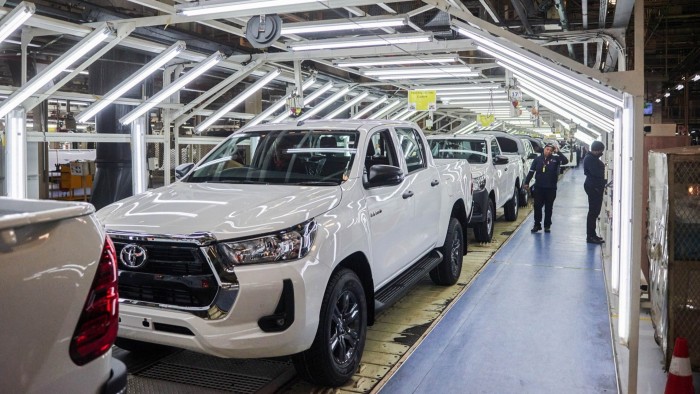Unlock the Editor’s Digest for free
Roula Khalaf, Editor of the FT, selects her favourite stories in this weekly newsletter.
When the US imposed a 25 per cent tariff on imported Japanese cars, the expectation had been higher sticker prices for US consumers and falling sales. The assumption was that the added costs to exporters would inevitably be passed down the line. Yet, months into the policy, the outcome has proven far less dramatic.
Japanese automakers’ US sales have shown surprising resilience. Toyota, for example, hit a global sales record in May, with North America sales up more than a tenth. Part of that is thanks to their local US production.
Behind the stable sales figures, export data tells a more troubling story. In May, the number of vehicles shipped to the US declined by just 3.9 per cent, according to official data. When export value is divided by the number of units sold, the average price per vehicle drops to about ¥3.5mn, or $24,000, roughly a fifth less than the previous year. By total value, Japan’s vehicle exports to the US fell by nearly a quarter.
If the cost of the tariffs had been passed on to consumers by raising prices, export volumes would probably have declined. But export value would have held steady, reflecting the higher per unit cost. Instead, both volume and value have fallen. That suggests carmakers are absorbing a large chunk of the tariff burden themselves.
This may be an effective short-term strategy. The US remains the most lucrative market for Japanese automakers. Even modest price increases risk undermining market share, as the companies face aggressive competition from American and South Korean rivals. For companies such as Toyota, Honda and Nissan, keeping prices stable could protect their long-term positioning in the country.
But trade negotiations have dragged on, with last week marking the seventh round of talks and little sign of resolution. If, as trade data suggests, companies are indeed absorbing the bulk of the tariff burden, their margins will be coming under growing pressure. That will squeeze even financially resilient groups such as Toyota, which has consistently reported operating margins above 10 per cent since 2023.
In choosing not to raise prices to fully offset tariffs, carmakers have delayed disruption, while gambling that politicians will come to an agreement before profit runs dry. But as Japan’s chief trade negotiator Ryosei Akazawa has noted, some local automaker executives now estimate losses of up to $1mn per hour under the current tariff structure.
Japan will need to act before losses reach the point where exports are no longer viable. That could mean buying more US energy or agricultural goods, or making market access concessions in areas such as food safety and pharmaceuticals. Discipline from its carmakers has bought time, but their resilience will soon be put to the test.
